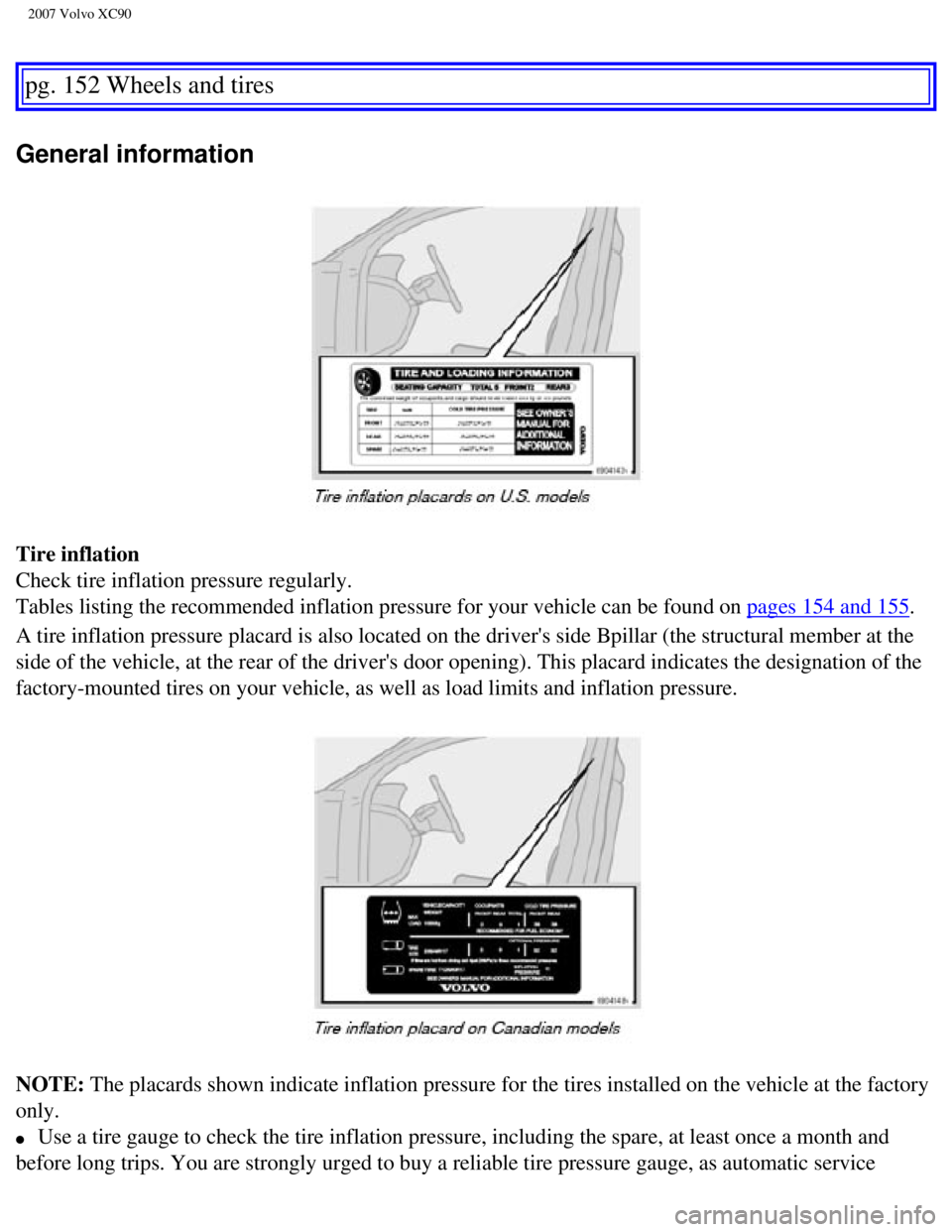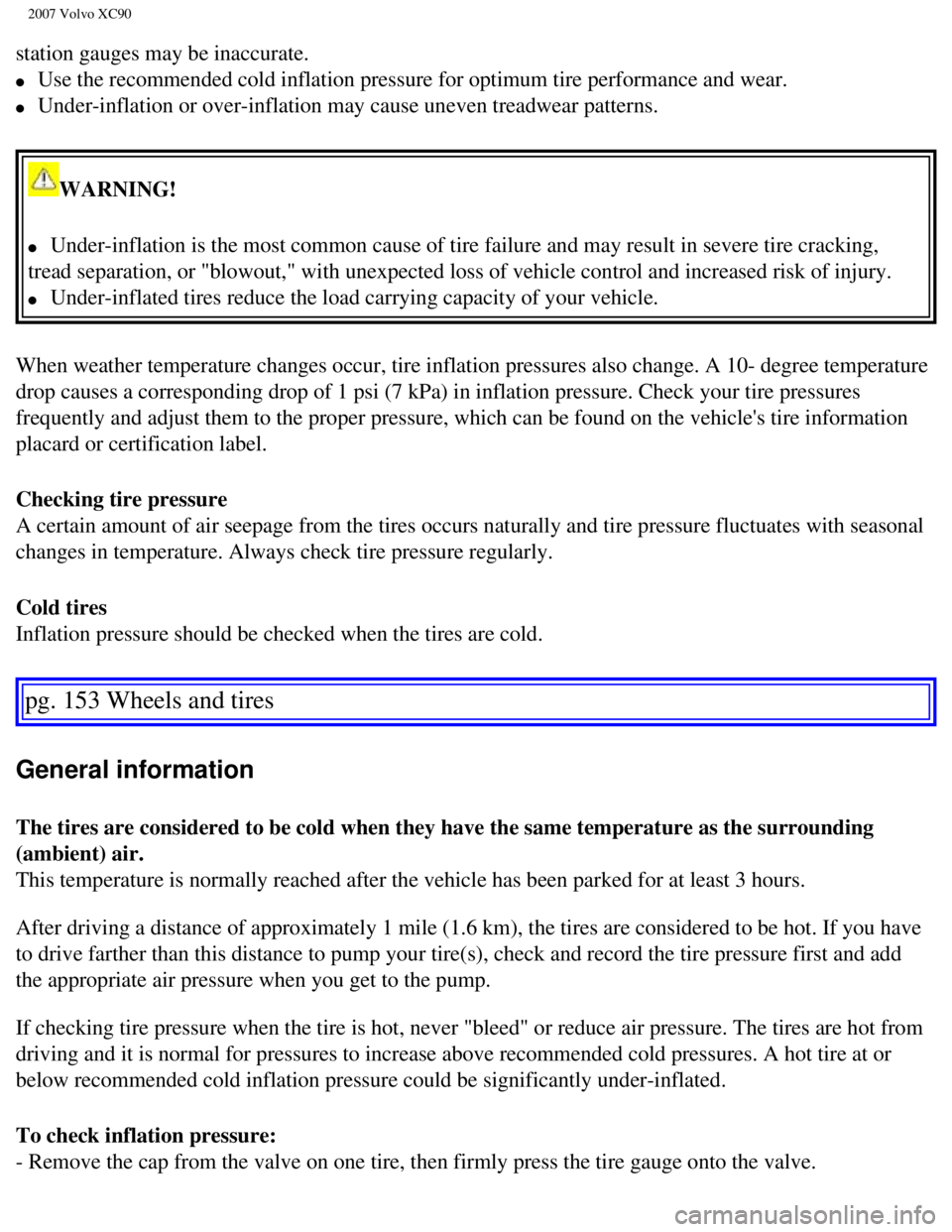2007 VOLVO XC90 inflation pressure
[x] Cancel search: inflation pressurePage 128 of 268

2007 Volvo XC90
WARNING!
Carbon monoxide is a poisonous, colorless, and odorless gas. It is prese\
nt in all exhaust gases. If you ever smell exhaust
fumes inside the vehicle, make sure the passenger compartment is ventila\
ted, and immediately return the vehicle to your
retailer for correction.
pg. 116 Starting and driving
Fuel requirements
WARNING!
Driving with the tailgate open: Driving with the tailgate open could lead to poisonous exhaust gases e\
ntering the
passenger compartment. If the tailgate must be kept open for any reason,\
proceed as follows:
l Close the windows
l Set the ventilation system control to air flow to floor, windshield and \
side windows and blower control to its highest
setting.
Weight distribution affects handling
At the specified curb weight your vehicle has a tendency to understeer, \
which means that the steering wheel has to be
turned more than might seem appropriate for the curvature of a bend. Thi\
s ensures good stability and reduces the risk of
rear wheel skid. Remember that these properties can alter with the vehic\
le load. The heavier the load in the cargo area, the
less the tendency to understeer.
Handling, roadholding
Vehicle load, tire design and inflation pressure all affect vehicle hand\
ling. Therefore, check that the tires are inflated to the
recommended pressure according to the vehicle load. See "Tire pressure" \
section. Loads should be distributed so that
capacity weight or maximum permissible axle loads are not exceeded.
Conserving electrical current
Keep the following in mind to help minimize battery drain:
l When the engine is not running, avoid turning the ignition key to positi\
on II (see page 121). Many electrical systems
(the audio system, the optional infotainment/ navigation systems, power\
windows, etc) will function with the ignition key
in position I. This position reduces drain on the battery.
l Please keep in mind that using systems, accessories, etc that consume a \
great deal of current when the engine is not
running could result in the battery being completely drained.
NOTE: A warning message will be displayed in the text window in the instrumen\
t panel when the battery charge is low.
pg. 117 Starting and driving
Refueling
file:///K|/ownersdocs/2007/2007_XC90/07xc90_06.htm (4 of 32)12/30/2006\
5:53:44 PM
Page 137 of 268

2007 Volvo XC90
W - Winter/Wet driving mode - enhanced vehicle traction
Press the button at the base of the gear selector to engage/disengage th\
is driving mode (see illustration).
l Mode W will only function if the gear selector is in the (D)rive position.
l When the W driving mode is engaged, this is displayed in the instrument \
panel (see page 46).
This mode may be selected for starting/ moving off on slippery roads.
1. Six-speed transmission: gears 2, 3, 4, 5, and 6.
pg. 126 Starting and driving
All Wheel Drive (option)
All Wheel Drive (AWD) - general information
Your Volvo can be equipped with permanent All Wheel Drive (option), wh\
ich means that power is distributed
automatically between the front and rear wheels. Under normal driving co\
nditions, most of the engine's power is directed
to the front wheels. However, if there is any tendency for the front whe\
els to spin, an electronically controlled coupling
distributes power to the wheels that have the best traction.
Tire dimensions
Volvo recommends that you always drive on tires of the same brand, size,\
construction (radial), tread pattern, load-,
speed-, traction- , temperature-, and treadwear rating. Never drive on m\
ixed tires, except for brief periods when the
temporary spare tire is in use.
Always use properly inflated tires of correct dimensions. Tire size and \
inflation pressures are shown on the tire inflation
pressure placards, located on the driver's side B-pillar (the structura\
l member at the side of the vehicle, at the rear of the
driver's door opening), or on the inside of the fuel filler door on Can\
adian models.
Temporary Spare
The temporary spare tire is for temporary, low-speed, short-distance use\
only. Replace it with a full-sized tire as soon as
possible. Do not drive on the temporary spare at speeds above 50 m.p.h. \
(80km/h) or for distances greater than 50 miles
(80 km).
Never install snow chains on a temporary spare.
pg. 127 Starting and driving
Brake system
file:///K|/ownersdocs/2007/2007_XC90/07xc90_06.htm (13 of 32)12/30/200\
6 5:53:44 PM
Page 147 of 268

2007 Volvo XC90
Towing a trailer
The maximum weights recommended by Volvo for trailers with brakes are shown in the table below.
NOTE:
l Recommended hitch tongue load: not more than 10% of the trailer's weight\
. The trailer load should be positioned
so that it does not shift and the tongue load should be 10% of the trail\
er's weight. However, the tongue load should not
exceed the maximum permissible weights indicated in the table above.
l When towing trailers without brakes, the maximum permissible trailer weight is 1,700 lbs (750 kg).\
l If necessary, redistribute the weight of any cargo in the trailer to avo\
id excessive weight on the trailer hitch.
l The maximum trailer weight listed in the table for All Wheel Drive model\
s, 5,000 lbs (2250 kg) is only applicable when
there are not more than two occupants in the vehicle, in the front seats\
, with a combined weight of 300 lbs (135 kg), with
no other cargo in the vehicle.
l The maximum weight listed for Front Wheel Drive models, 4,000 lbs (1800\
kg) is only applicable when there are not
more than four occupants in the vehicle, in the front seats and second r\
ow of seats, with a combined weight of 600 lbs (270
kg), with no other cargo in the vehicle.
pg. 138 Starting and driving
Towing a trailer
l Please be aware that the load on the trailer hitch is part of the vehicl\
e's total load carrying capacity. The amount of cargo
in the vehicle and the trailer must be limited so that the gross vehicle\
weight and maximum permissible rear axle weight
(see
page 209) are not exceeded.
l Vehicles used for towing a trailer on a regular basis, or for long-dista\
nce highway towing should be equipped with an
automatic transmission oil cooler and Volvo's automatic self-leveling sy\
stem for the rear suspension. Consult your Volvo
retailer.
l Volvo recommends the use of Volvo trailer hitches that are specially des\
igned for the vehicle.
l All Volvo models are equipped with energy-absorbing shock-mounted bumper\
s. Trailer hitch installation should not
interfere with the proper operation of this bumper system.
l Increase tire pressure to recommended full inflation pressure. See chapt\
er "Wheels and tires."
l When your vehicle is new, avoid towing heavy trailers during the first 6\
20 miles (1,000 km).
l Engine and transmission are subject to increased loads. Therefore, engin\
e coolant temperature should be closely
file:///K|/ownersdocs/2007/2007_XC90/07xc90_06.htm (23 of 32)12/30/200\
6 5:53:44 PM
Page 157 of 268

2007 Volvo XC90
2 0 0 7
VOLVO XC90
Wheels and tires
pg. 149 Wheels and tires
General information 150
Tire inflation pressure tables - U.S. models
154
Tire inflation pressure tables - Canadian models
155
Tire Pressure Monitoring System (TPMS) -
option
156
Tire designations
159
Glossary of tire terminology
160
Vehicle loading
161
Uniform Tire Quality Grading
163
Snow chains, snow tires, studded tires
164
Temporary spare
165
Changing wheels
166
pg. 150 Wheels and tires
General information
Your vehicle is equipped with tires according to the vehicle's tire info\
rmation placard on the B-pillar
(the structural member at the side of the vehicle, at the rear of the d\
river's door opening), or on the inside
of the fuel filler door on Canadian models.
The tires have good road holding characteristics and offer good handling\
on dry and wet surfaces. It
should be noted however that the tires have been developed to give these\
features on snow/ice-free
surfaces.
Certain models are equipped with "all-season" tires, which provide a som\
ewhat higher degree of road
holding on slippery surfaces than tires without the "all-season" rating.\
However, for optimum road
file:///K|/ownersdocs/2007/2007_XC90/07xc90_07.htm (1 of 23)12/30/2006\
5:53:47 PM
Page 159 of 268

2007 Volvo XC90
General information
WARNING!
l The wheel and tire sizes for your Volvo are specified to meet stringent \
stability and handling
requirements. Unapproved wheel/tire size combinations can negatively aff\
ect your vehicle's stability
and handling. Approved tire sizes are shown in the Tire inflation pressu\
re tables on
page 154.
l Any damage caused by installation of unapproved wheel/tire size combinat\
ions will not be covered
by your new vehicle warranty. Volvo assumes no responsibility for death,\
injury, or expenses that
may result from such installations.
New tires
Remember that tires are perishable goods. As of 2000, the manufacturing \
week and year will be
indicated with 4 digits (e.g. 1502 means that the tire illustrated was \
manufactured during week 15 of
2002).
Tire age
Tires degrade over time, even when they are not being used. It is recomm\
ended that tires generally be
replaced after 6 years of normal service. Heat caused by hot climates, f\
requent high loading conditions
or Ultra Violet (U.V) exposure can accelerate the aging process.
You should replace the spare tire when you replace the other road tires \
due to the aging of the spare.
A tire's age can be determined by the DOT stamp on the sidewall (see th\
e illustration above).
A tire with e.g., visible cracks or discoloration should be replaced imm\
ediately.
Improving tire economy:
l Maintain correct tire pressure. See the tire pressure table on page 154.
l Drive smoothly: avoid fast starts, hard braking and tire screeching.
l Tire wear increases with speed.
l Correct front wheel alignment is very important.
l Unbalanced wheels impair tire economy and driving comfort.
l Tires must maintain the same direction of rotation throughout their life\
time.
When replacing tires, the tires with the most tread should be mounted on\
the rear wheels to reduce the
chance of oversteer during hard braking.
Hitting curbs or potholes can damage the tires and/or wheels permanently\
.
file:///K|/ownersdocs/2007/2007_XC90/07xc90_07.htm (3 of 23)12/30/2006\
5:53:47 PM
Page 160 of 268

2007 Volvo XC90
pg. 152 Wheels and tires
General information
Tire inflation
Check tire inflation pressure regularly.
Tables listing the recommended inflation pressure for your vehicle can b\
e found on
pages 154 and 155.
A tire inflation pressure placard is also located on the driver's side B\
pillar (the structural member at the
side of the vehicle, at the rear of the driver's door opening). This pl\
acard indicates the designation of the
factory-mounted tires on your vehicle, as well as load limits and inflat\
ion pressure.
NOTE: The placards shown indicate inflation pressure for the tires installed \
on the vehicle at the factory
only.
l Use a tire gauge to check the tire inflation pressure, including the spa\
re, at least once a month and
before long trips. You are strongly urged to buy a reliable tire pressur\
e gauge, as automatic service
file:///K|/ownersdocs/2007/2007_XC90/07xc90_07.htm (4 of 23)12/30/2006\
5:53:47 PM
Page 161 of 268

2007 Volvo XC90
station gauges may be inaccurate.
l Use the recommended cold inflation pressure for optimum tire performance\
and wear.
l Under-inflation or over-inflation may cause uneven treadwear patterns.
WARNING!
l Under-inflation is the most common cause of tire failure and may result \
in severe tire cracking,
tread separation, or "blowout," with unexpected loss of vehicle control \
and increased risk of injury.
l Under-inflated tires reduce the load carrying capacity of your vehicle. \
When weather temperature changes occur, tire inflation pressures also ch\
ange. A 10- degree temperature
drop causes a corresponding drop of 1 psi (7 kPa) in inflation pressur\
e. Check your tire pressures
frequently and adjust them to the proper pressure, which can be found on\
the vehicle's tire information
placard or certification label.
Checking tire pressure
A certain amount of air seepage from the tires occurs naturally and tire\
pressure fluctuates with seasonal
changes in temperature. Always check tire pressure regularly.
Cold tires
Inflation pressure should be checked when the tires are cold.
pg. 153 Wheels and tires
General information
The tires are considered to be cold when they have the same temperature \
as the surrounding
(ambient) air.
This temperature is normally reached after the vehicle has been parked f\
or at least 3 hours.
After driving a distance of approximately 1 mile (1.6 km), the tires a\
re considered to be hot. If you have
to drive farther than this distance to pump your tire(s), check and re\
cord the tire pressure first and add
the appropriate air pressure when you get to the pump.
If checking tire pressure when the tire is hot, never "bleed" or reduce \
air pressure. The tires are hot from
driving and it is normal for pressures to increase above recommended col\
d pressures. A hot tire at or
below recommended cold inflation pressure could be significantly under-i\
nflated.
To check inflation pressure:
- Remove the cap from the valve on one tire, then firmly press the tire \
gauge onto the valve.
file:///K|/ownersdocs/2007/2007_XC90/07xc90_07.htm (5 of 23)12/30/2006\
5:53:47 PM
Page 162 of 268

2007 Volvo XC90
- Add air to reach the recommended air pressure.
- Replace the valve cap.
- Repeat this procedure for each tire, including the spare.
- Visually inspect the tires to make sure there are no nails or other ob\
jects embedded that could puncture
the tire and cause an air leak.
- Check the sidewalls to make sure there are no gouges, cuts, bulges or \
other irregularities.
NOTE:
l If you overfill the tire, release air by pushing on the metal stem in th\
e center of the valve. Then
recheck the pressure with your tire gauge.
l Some spare tires require higher inflation pressure than the other tires.\
Consult the tire inflation table
on
page 154 or see the inflation pressure placard.
pg. 154 Wheels and tires
Tire inflation pressure tables - U.S. models
The following tire pressures are recommended by Volvo for your vehicle. \
Refer to the tire inflation
placard for information specific to the tires installed on your vehicle \
at the factory.
Cold tire pressures up to five persons
Tire size Front, psi
(kPa) Rear, psi (kPa)
XC90
235/65R17
235/60R18
255/50R19 36 (250)
36 (250)
Temporary spare tire
T155/85R18 61 (420)
61 (420)
Load ratings
The load ratings in the tables above translate as follows:
91 = 1365 lbs (615 kg), 93 = 1433 lbs (650 kg), 99 = 1709 lbs (755 \
kg)
Speed ratings
The speed ratings in the tables translate as follows:
M = 81 mph (130 km/h), V= 149 mph (240 km/h), W= 168 mph (270 km/h)\
See also
page 159 for an explanation of the designations on the sidewall of the tire.
file:///K|/ownersdocs/2007/2007_XC90/07xc90_07.htm (6 of 23)12/30/2006\
5:53:47 PM